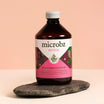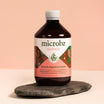The first week of November is Global Prebiotics Week. Anything which promotes a conversation about gut health and awareness is good for us, but it got us thinking: is it universally understood what these terms prebiotic and probiotic even mean?
They sound very similar and with the gut health conversation gaining traction, they are increasingly bandied about. But what are they, and how can we practically and simply use them in our lives to improve our health?
What are Prebiotics?
Prebiotics are essentially just food, just ingredients. But they are the ones that particularly help the bacteria (or microbes) in your gut thrive. Prebiotics are plant fibres which act as a food source for your 'good' bacteria.
To enhance gut health, we want to be taking any actions which help boost the beneficial bacteria, anything which will help them thrive and be in the majority.
In very simplistic terms, all of the basic healthy habits such as exercising, getting fresh air and plenty of sleep will help put the odds in favour of beneficial bacteria.
Eating prebiotic foods is another one of those healthy habits which contribute to helping your microbiome thrive, resulting in better gut and overall health. As well as fuelling the bacteria, consuming prebiotic foods can:
- Help you absorb calcium
- Help your body manage spikes in blood sugar
- Help you ferment foods faster, so they spend less time in your digestive system, maintaining a healthy regular digestive system.
- Help to keep the cells that line your gut healthy
What's the difference between prebiotic and a probiotic?
A prebiotic is food that helps beneficial bacteria to thrive. And those beneficial bacteria are probiotics. For example; the microbz probiotic range contain live strains of active bacteria. The most common groups of beneficial microbes in probiotics are Lactobacillus and Bifidobacterium. Consuming prebiotics will feed these bacteria and encourage them to thrive in your system.
Examples of Prebiotic Foods
You'll find prebiotics in many fruits, vegetables, and whole grains like:
- Apples
- Artichokes
- Asparagus
- Bananas
- Barley
- Berries
- Chicory
- Cocoa
- Flaxseed
- Garlic
- Green vegetables
- Sweet Potato
- Leeks
- Legumes (like peas and beans)
- Oats
- Onions
- Tomatoes
- Soybeans
- Wheat
We love this example of a gut-health-enhancing recipe Prebiotic Superfood Stew by The Happy Pear. It contains some great prebiotic food types like tomatoes, lentils, beans and sweet potato - and it's also a great example of eating seasonally which we always advocate! If you have any further questions about prebiotics, probiotics or general gut health don't forget you can always submit your questions to our resident nutritionist Zara using this link. If you want to give your microbiome a good healthy boost of probiotics, shop the microbz range here.




































